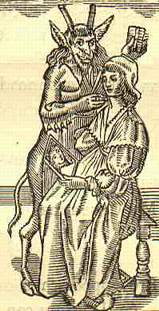The demon sex
The tendency of the medieval Church to espouse misogyny (Eve was to blame for it all) led to a fear of female sexuality, one expression of which was a belief in the licentiousness of witches.
In this illustration, the devil, in the disguise of a simple country fellow, seduces a young woman. The major textbook of witch-hunters, the Malleus Maleficarum (Hammer of Witches), spends several chapters on the way the devil copulates with witches, the way they are able to make men impotent, or even make their penises disappear, and the indecent pleasure they get from the act with the devil.
Penalties for witchcraft
"All using occult arts, were it even to discover stolen goods, are adjudged guilty of felony with pain of death" (an Act of Parliament, 1542, 1563; not repealed until 1763).
In the whole horrifying history of the persecution of witches, the penalties for witchcraft or sorcery are the most graphic illustrations of the suffering inflicted. At least in England, only "witches" also found guilty of treason or heresy were burned alive*. Others were hanged*, or, if they were lucky, merely imprisoned or put in the pillory.
Footnotes
-
No rest for the wicked
As well as copulating with incubi--devils disguised as men--witches were supposed to interfere with childbirth, causing abortion or miscarriage, and midwives in particular were accused of killing or sacrificing children. The Malleus explains that the devil, through witches, can interfere with sexual matters because "God allows them more power over this act, by which the first sin was continued."
-
Burning witches in Scotland
Burning at the stake was the preferred form of punishment for witchcraft in Scotland, the homeland of James I.
-
Witches under the law
The death penalty (by hanging) was prescribed for "consulting, covenanting with, entertaining, employing, feeding or rewarding any evil spirit; invocation or conjurations of demons; taking up any body from the grave, or securing any skin, bone, or part of a corpse to employ any manner of witchcraft or enchantment."
Under Elizabeth the penalties were somewhat more lenient: for intent to "hurt persons in body or to waste and destroy goods" a first offence put the woman in the pillory for six hours and in jail for a year; under James the penalty was death.
Executions were very public affairs, the intent being to deter others, though contemporary accounts suggest that the spectacle was relished rather than feared.
